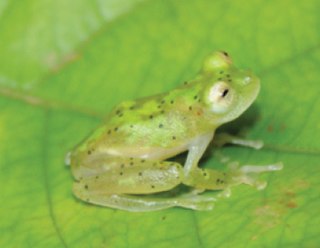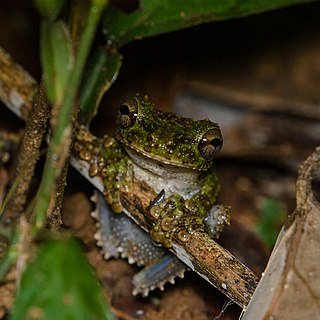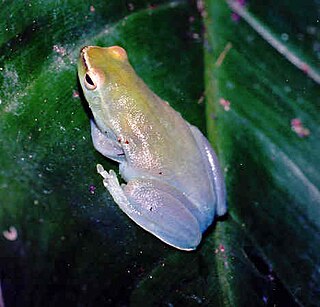
Hyalinobatrachium iaspidiense is a species of frog in the family Centrolenidae from South America. Its specific name refers Quebrada de Jaspe, its type locality.

Osteocephalus cabrerai is a species of frog in the family Hylidae. It is found in the Amazon Basin in Brazil (Manaus), northeastern Peru, Ecuador, Colombia, Guyana, and French Guiana, possibly wider. Some earlier records refer to Osteocephalus buckleyi.
Osteocephalus deridens is a species of frog in the family Hylidae. It is found in the Napo and Pastaza River drainages in eastern Ecuador and in the Loreto Region, northern Peru. The specific name deridens is derived from Latin deridere, meaning "make fun of someone". This alludes to the males calling from the treetops that sound "as if they are laughing at the collectors' vain attempts to reach them". Common name funny slender-legged treefrog has been coined for this species.

Osteocephalus yasuni is a species of frogs in the family Hylidae. It is found in the upper Amazon Basin in southern Colombia, Ecuador, and northeastern Peru at elevations of 70–250 m (230–820 ft) above sea level. The specific name yasuni refers to the Yasuni National Park where its type locality is.

Sphaenorhynchus dorisae, the Doris' lime treefrog, is a species of frog in the family Hylidae. It is found in the upper Amazon Basin of southeastern Colombia, Ecuador, Brazil and Peru. It might also be present in Bolivia.

Sphaenorhynchus lacteus, the Orinoco lime treefrog or greater hatchet-faced treefrog, is a species of frog in the family Hylidae. It is a widely distributed species found in the Orinoco and Amazon basins in Venezuela, the Guianas, Colombia, Brazil, Ecuador, Peru, and Bolivia. It also occurs in Trinidad and Tobago.
Strabomantis cornutus is a species of frog in the family Strabomantidae. It is found along the eastern flank of the Andes of Ecuador and Colombia north to Caquetá Department. Common name Rio Suno robber frog has been coined for it. It has been confused with other species.
Pristimantis croceoinguinis is a species of frog in the family Strabomantidae. It is found in the lowland Amazon rainforest of southern Colombia, eastern Ecuador, and extreme north-eastern Peru, likely also extending into the adjacent Brazil. The specific name croceoinguinis refers to the color of the inguinal spots of this frog. Common name Santa Cecilia robber frog has been proposed for it.
Pristimantis eremitus is a species of frog in the family Strabomantidae. It is found in the Cordillera Occidental in north-western Ecuador from the Cotopaxi Province northward and on western slope of the Colombian Massif in the Nariño Department, extreme south-western Colombia. The specific name eremitus is Latin for "lonely" or "solitary" and refers to this species being the only western-Andean species among its closest relatives. Common names Chiriboga robber frog and lonely rainfrog have been coined for it.
Yunganastes fraudator is a species of frog in the family Strabomantidae. It is endemic to Bolivia and found in the Cochabamba Department to the border with the Santa Cruz Department. It is sometimes known as Cochamba robber frog. Its specific name fraudator means "cheat" or "deceiver" and refers to its resemblance with Gastrotheca marsupiata.

Pristimantis leptolophus is a species of frog in the family Strabomantidae. It is endemic to Colombia and known from the páramos of the Colombian Massif and Cordillera Central in the departments of Cauca and Huila. The specific name leptolophus is derived from Greek leptos ("thin") and lophos ("crest") and refers to the low dorsolateral folds of this frog. Common name volcano robber frog has been coined for it.
Pristimantis luscombei is a species of frog in the family Strabomantidae. It is known from north-eastern Peru, adjacent Amazonian Ecuador, and from Acre state, Brazil. Some of the paratypes were later identified as belonging to another species, described in 2014 as Pristimantis miktos. At the same time, Pristimantis achuar was identified as synonym of Pristimantis luscombei.
Yunganastes mercedesae is a species of frog in the family Strabomantidae. It is found in Bolivia and southern Peru. It is sometimes known as Mercedes' robber frog. It is named after Mercedes S. Foster, who collected the holotype and was acknowledged for her herpetological collection efforts in South America.

Pristimantis pycnodermis, also known as thickskin robber frog, is a species of frog in the family Strabomantidae. It is endemic to the Ecuadorean Andes and occurs in the Cordillera de Matanga in the Azuay and Morona-Santiago Provinces. The specific name pycnodermis is Greek and means "thick skin", a characteristic of this species.
Pristimantis rosadoi is a species of frog in the family Strabomantidae. It is found in north-western Ecuador in Carchi, Esmeraldas, and Pichincha provinces, and in the adjacent Colombia in the Nariño Department as well as on the Gorgona Island; there is some doubt about the identity of the Gorgona Island specimens, while the checklist of Colombian amphibians only mentions the Gorgona record. The specific name rosadoi honors José P. O. Rosado, herpetologist at the Museum of Comparative Zoology, and also alludes to similarity of this species to Pristimantis roseus. Common name Rosado's robber frog has been proposed for it.
Pristimantis tribulosus is a species of frog in the family Strabomantidae. It is endemic to Colombia and is only known from the vicinity of its type locality near Samaná in the Caldas Department, on the eastern slope of the Cordillera Central. The specific name tribulosus, meaning "thorny", refers to the numerous tubercles that cover the upper surfaces of this species.
Pristimantis vertebralis is a species of frog in the family Strabomantidae. It is endemic to the Andes of Ecuador and occurs in the Carchi, Imbabura, Pichincha, Cotopaxi, Bolívar, and Azuay provinces. Common name vertebral robber frog has been coined for it.
Noblella lochites, also known as Ecuador leaf frog, is a species of frog in the family Strabomantidae. It is found on the Amazonian slopes of the Andes and Cordillera del Cóndor and the Cordillera de Cutucú in Ecuador and Peru; the Peruvian record has been disputed, although it is nevertheless expected that the species occurs in Peru.

Noblella is a genus of frogs in the family Strabomantidae. They are found on the eastern slopes of the Andes and in the Amazon Basin in Colombia, Ecuador, Peru, Bolivia, and western Brazil. The name refers to Gladwyn K. Noble, who described the first species.

Noblella madreselva is a species of frog in the family Strabomantidae. The species is only known from its type locality, Madre Selva in the La Convención Province, Cusco, Peru.









